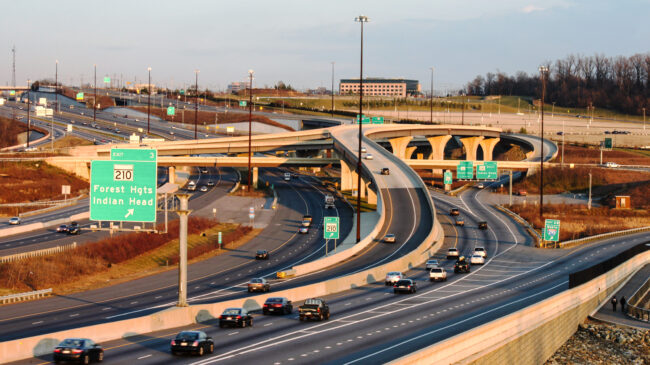Earlier this month, Transurban, a toll road company operating roads in the United States, Canada, and Australia, announced that the Accelerate Maryland Partners team is terminating its agreement with the state of Maryland to build two variably priced managed lanes (two in each direction) on portions of Interstate 270 and Interstate 495 in Montgomery County.
The proposal also would have retrofitted and widened the American Legion Bridge over the Potomac River, which connects Maryland and Virginia. And the project’s phase 1A included hundreds of millions of dollars for transit service in Montgomery County, and in phase 1B, more than $500 million for additional transit service in Frederick County. Transurban withdrew because of challenges related to environmental approvals, higher project costs, unresolved lawsuits, and new political leadership.
When Maryland Gov. Wes Moore was elected last November, he promised to steer the project in a new direction. Still, most industry insiders expected Moore to approve a similar, if slimmed-down, project. Accelerate Maryland Partners (AMP) was frustrated with the pace with which the state was moving. In large public-private partnerships P3s, time is money. And between rising interest rates and a 50% increase in material and labor costs, the project’s price was increasing every month.
What are the governor’s options now?
Maryland could do what it has been doing for the past 20 years—nothing. This will lead to a host of problems. First, the American Legion Bridge is reaching the end of its life, and it needs major renovations to be structurally sound.
Second, without any new highway capacity, it is not practical to operate any type of transit service in the corridor because the vehicles would creep along at the same slow speeds as the automobiles. Fairfax County, Virginia, and Montgomery County, Maryland, have the two largest populations in the Washington D.C.-region, and there is no transit service between the two.
Grading on a scale of “A” to “F,” I would give the option of doing nothing an “F.” Thankfully, most elected officials agree that doing nothing is not a realistic option.
A slightly better, but still mediocre, option would be to add two-to-four general-purpose lanes to the corridor. These highway lanes would help reduce traffic congestion and allow more reliable transit service. But with the amount of demand on the corridor, any relief is minor.
In addition, state taxpayers would have to cover the project’s entire cost since there would be no tolling to generate revenue. And the environmental groups that did not like new priced lanes would likely strongly oppose new ‘free’ highway lanes. Given the risks and amount of money needed from taxpayers, I would give this option a “C” at best.
A better option, and seemingly the most likely to occur, is for the state to take over the construction and operation of the express toll lanes and the bridge. This would allow the project to be constructed and the American Legion Bridge to be rebuilt. Maryland used this option to build and expand managed lanes on I-95 northeast of Baltimore. Maryland could leverage its toll facilities, including two toll tunnels, three bridges, the Intercounty Connector, and the existing I-95 express lanes, to finance at least part of the project. Some of these toll facilities provide extra revenue beyond what is needed for capital, operations, and maintenance costs, while others require cross-subsidies, so there is a limit to how much of the planned I-270/I-495 express lanes could be financed in this manner. While this option is better than the no-build or non-toll lanes alternatives, it is more of a grade of “B” because it is still far from perfect.
With this option, the state government keeps all the risks. If a sudden economic downturn reduces toll revenue on any of the facilities, taxpayers are on the hook for the extra revenue needed to cover project costs. If the interest rates increase faster than expected, taxpayers must cover the difference. Further, the AMP proposal provided millions to improve local transit service in the region. The option would provide the virtual exclusive lanes for transit but not the operations or maintenance funding for the vehicles.
The best option, and the one I would give a grade of “A” to, would be for Maryland to contract with one of the short-listed private-sector teams to build the project. The challenge for short-listed teams is with the rising project costs, none of these teams may be interested or have the ability to build the project and provide the transit subsidy that Maryland wants.
Maryland leaders need to make a decision. How will they solve one of the worst transportation bottlenecks, replace an aging bridge, and provide transit service between the region’s two largest counties?
Reconstructing the bridge and adding state-financed managed lanes should be the bare minimum option. Finding a way to revive the managed lanes public-private partnership to transfer risk from taxpayers and to provide more transit options for commuters should be the goal.

